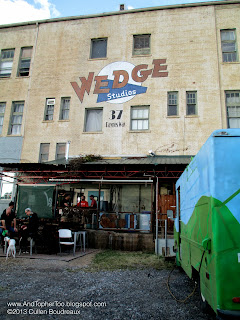Atlanta has been my home for most of my life but it wasn't until I settled in historic Grant Park that I truly felt I'd found where I belonged. As a child growing up in Dunwoody (an Atlanta suburb) I was very aware of the lack of history around me. The most historic thing about my suburb was the old Spruill Farm House (and I was enamored by it). So it's no surprise that when I moved to Providence, Rhode Island for college I enthusiastically consumed as much local history as I could get my hands on. The campus tours I led for the RISD admissions office focused as much on the history of the city as it did the school. (And there was plenty to share: ranging from the building where George Washington renounced the colonies allegiance to King George III to tunnels used by the Underground Railroad).
Thirteen years later, I'm back in Atlanta as a resident of a Grant Park, a nationally recognized historic district. This history of my neighborhood is accessible and interesting and I find myself pouring over it at every opportunity. Not everyone loves history as much as I do - but I do believe everyone loves a good story and some fun facts. To that end I complied a little timeline marking events I think Grant Parkers might find interesting:
• 1821 - Creek Indians give up territory that will eventually become modern day Atlanta
• 1836 - The Western and Atlantic Railroad plans a route to connect Savannah to the Midwest. The initial track runs from Chattanooga to a spot near the Chattahoochee - this spot is marked as "mile post zero". The community that grows up around it becomes known as "Terminus" aka "the end of the line". John Thrasher is hired by the Western and Atlantic Railroad to develop the area's first homes and a general store for railroad workers. The community takes on his name: Thrasherville. (Current day: Marietta Blvd across from Fairlie-Polar District).
• 1842 - Terminus/Thrasherville is renamed "Marthasville" after Governor Wilson Lumpkin's daughter, Martha. When Martha Lumpkin dies in 1917 she is buried in the original 6 acres of Oakland Cemetery.
• 1843- Lemuel P. Grant, an engineer with the railroad who owns more the 600 acres around the area, donates some of his land to the city prompting the railroad to move the track's end to the donated land and away from Thrasher's general store. Thrasher is so upset that he moves to Griffin. (I question the validity of this story)
• 1845 - A chief engineer of the Georgia Rail Road suggests renaming the city "Atlantica-Pacifica" (presumably referencing: from the Atlantic to the Pacific).
• 1847 - "Atlanta" officially becomes Atlanta.
• 1850 - Oakland Cemetery is founded
• 1856 - Lemuel P. Grant builds his home in Grant Park
• 1861 - the American Civil War begins
• 1864 - Battle of Atlanta. Battle lines follow current Moreland Avenue south from the Edgewood shopping center to I-20 where they make a 90 degree turn towards the west. Sherman burns an estimated 3,200 to 5,000 buildings - sparing about 400. Lemuel P. Grant's home is spared because of the Masonic paraphernalia found on the property.
• 1865 - Civil War ends, Atlanta begins rebuilding.
• 1880 - Atlanta's population hits 37,500. It is the largest city between Richmond, Virginia and New Orleans, Louisiana. (Note: Turner Field's current capacity is 50,000).
• 1882 - Lemuel P. Grant donates 100 acres of his land for the formation of Grant Park and the surrounding neighborhood. Today the neighborhood is home to most of Atlanta's original Victorian architecture.
• 1889 - A traveling circus goes bankrupt and abandons it's animals in Grant Park. Zoo Atlanta is formed.
• 1893 - Lemuel Grant dies in the overgrown Victorian home at the corner of Sydney and Hill St.
• 1902 - Golf legend Bobby Jones is born in the master bedroom of Grant Lemuel's first home.
• 1940s - Margaret Mitchell starts a campaign to save the Grant mansion but is cut short when killed by a taxi on Peachtree at 13th Street.
• 1960's and 1970's - Interstates 75/85/20 separate Grant Park from the rest of Atlanta
I'm interested in knowing more about the similarities and differences between the development of Grant Park and it's contemporary neighbor Inman Park. If anyone has information on how the two neighborhoods were viewed, relative to one another in the 1880s, I'd love to hear/read it!























